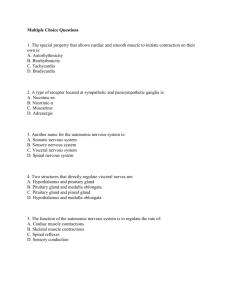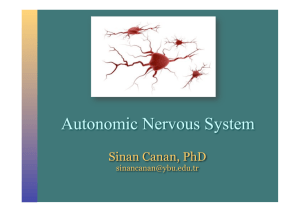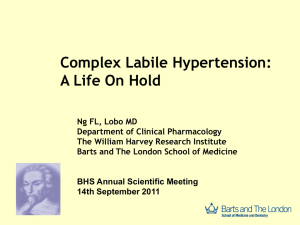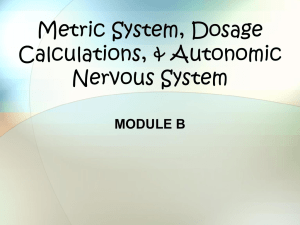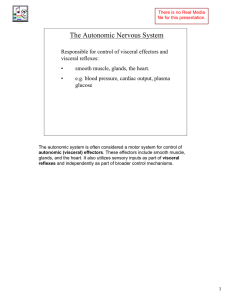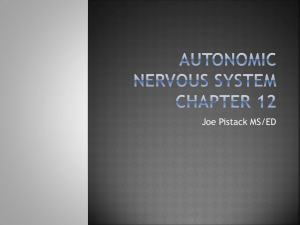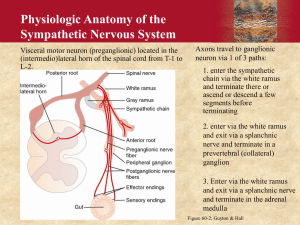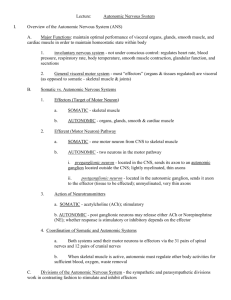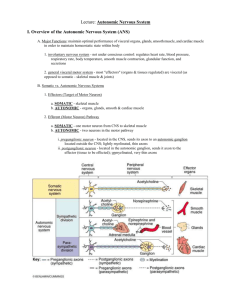NMS Systems-Lecture 13-Introduction to the Autonomic Nervous
advertisement
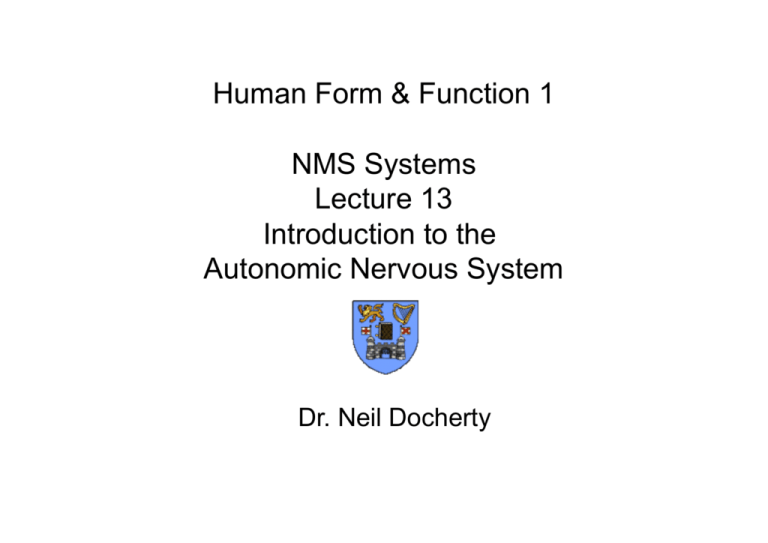
Human Form & Function 1 NMS Systems Lecture 13 Introduction to the Autonomic Nervous System Dr. Neil Docherty My Teaching Objectives • To define the two autonomic branches of the efferent arm of the peripheral nervous system • To revise the similarities and differences in the structure of autonomic fibres according to the “twochain” hypothesis. • To systematically introduce the autonomic neurotransmitters, their receptors, modes of signal transmission and agonism/antagonism • To describe the concept of autonomic tone and dominance with a focus on the myocardium Efferent Branches of The Peripheral Nervous System • Communication link between afferent visceral/sensory input to CNS integration and effector function afferent visceral/sensory input C.N.S. Electrical conduction/Chemical transmission (neurotransmission) Autonomic Nervous System (A.N.S.) Somatic Nervous System (S.N.S.) Effector function USUALLY SUBCONSCIOUS AND INVOLUNTARY • Motility Related (Cardiac muscle and smooth muscle) • Secretory (glands) • Metabolic (liver and adipose tissue) OFTEN CONSCIOUS AND VOLUNTARY • Skeletal muscle Summary of A.N.S. Organisation THORACOLUMBAR (SYMPATHETIC) CRANIOSACRAL (PARASYMPATHETIC) Adapted from Figure 7-2 Human Physiology Cells to Systems (7th Ed.) Sherwood L. p234 A.N.S. Efferent Pathways Are Formed by a Two Neuron Chain Direction of impulse Multiple inputs Multiple outputs (varicosities) Adapted from Figure 7-1 Human Physiology Cells to Systems (7th Ed.) Sherwood L. p234 C.N.S. Control Centres for A.N.S. • Spinal cord level -autonomic reflexes (urination, defecation) • Brain Stem -Medulla Oblongata -cardiovascular, respiratory and digestive centres • Hypothalamus -Superordinate to medulla in emotional and behavioural responses • Pre-frontal Association Cortex -Superordinate to autonomic manifestations of emotional expression (e.g. blushing) Summary Branches of the A.N.S. ORIGIN STRUCTURE GANGLIA LOCATION Sympathetic Parasympathetic Thoracic/Lumbar Craniosacral Short pre-ganglionic Long pre-ganglionic Long post-ganglionic Short post-ganglionic Paravertebral Collateral Terminal (at or very near organ) The Autonomic Neurotransmitters Chemical signals required to integrate a multitude of finally tuned responses However, only two main neurotransmittors ACETYLCHOLINE (ACh) NORADRENALINE KEY CONCEPT This makes us think that the diversity of responses is a function of the way the signal is received • Tissue specialisation • Receptor effects • Potential for pharmacological modulation of responses by interfering with receptor activation A.N.S. Neurotransmitters PRE-GANGLIONIC ACh in both branches POST-GANGLIONIC 1. Sympathetic • Primarily noradrenaline (Adrenergic fibres) 2. Parasympathetic • Primarily ACh (Cholinergic fibres) The Adrenal Medulla -A Modified Sympathetic Ganglion • The adrenal gland is part of the endocrine system • Sympathetic pre-ganglionic fibres directly stimulate the adrenal medulla (neuroendocrine chromaffin cells) • Chromaffin cells synthesise adrenaline from tyrosine in response to stimulation • N.B.adrenaline gives rise to similar effects to noradrenaline except via the bloodstream Signal Transmission-1 Adrenergic Receptor Subtypes Alpha and Beta subtypes Alpha-Two classes ( α1/ α2) -Bind NA>A - α1 Calcium second messenger EXCITATORY e.g. peripheral vasoconstriction - α2 Blockade of cAMP second messenger INHIBITORY e.g. decreased digestive tract activity Beta-Two classes ( β1/ β2) - β1 NA + A equal affinity β2 primarily A -cAMP second messenger system - β1-Principally cardiac e.g. increases rate and force of contraction - β2-Primarily inhibitory e.g bronchiolar dilatation Adrenergic Receptor Signal Transmission ALPHA 1 BETA Three types (A,B,D) All Increase PKC and Ca2+ 2 types (1 and 2) -β1-increase Ca2+ Increase heart rate and force Increase smooth muscle contraction ARTERIOLAE ALPHA 2 3 types (A,B,C) All Decrease cAMP and Ca2+ Decrease secretory activity GI TRACT ENDOCRINE AND EXOCRINE GLANDS -β2-decrease Ca2+ Smooth muscle relaxation e.g. bronchiolar dilatation Signal Transmission 1 Cholinergic Receptor Subtyes Nicotinic (N) • All autonomic ganglia • Binding stimulates inward cation flow in postganglionic cell (ionotropic) • Muscarinic (M) • On effector cell membranes innervated by parasympathetic branch • G protein, second messenger system linked. • Five classes (M1 to M5) • Divergent effects e.g. relaxation of cardiac muscle and contraction of smooth muscle Nicotinic and Muscarinic Receptor Signal Transmission NICOTINIC MUSCARINIC http://www.atsdr.cdc.gov/csem/cholinesterase/images/muscarinic_receptor.png Dual A.N.S. Innervation GENERAL RULE Sympathetic and parasympathetic usually have directly opposing effects on function e.g heart rate, contractility) Adapted from Figure 7-3 Human Physiology Cells to Systems (7th Ed.) Sherwood L. p234 Exceptions to Dual Innervation Effect Rule • Resistance vessels (arteriolae) receive only direct sympathetic input. (penis and clitoris excepted) • Sweat glands receive sympathetic cholinergic input • Salivary gland secretion increased by both sympathetic and parasympathetic (qualitative differences in resultant saliva due to balance of inputs) Autonomic Tone • Partial activity of both branches exerts a tonic effect on target organs • Can give way to dominance (one up-one down shift in action potential frequency) • Can occur at single organ level in response to detection of a change in set-points interpreted by integrating centres-HOMEOSTATIC CONTROL • Large scale widespread activation more common in sympathetic branch (e.g fight or flight) Sympathetic Dominance The Fight or Flight Response A “Tour de Force” in Sympathetic Dominance • In response to emergency/stressful situations the body must prepare for a potential threat to be faced PARAMETER REQUIRMENT SYMPATHETIC EFFECT Parasympathetic dominance “Rest and Digest” Nocturnal Dip (heart rate variability) Post-prandial dip ( parasympathetic branch dominant in digestion and Absorption) M2 Cholinergic Receptors in the Myocardium Contrast the detail here with that mentioned before regarding adrenergic input in the myocardium The details reveals the physiological explanantion for the inhibitory effects of the parasympathetic branch on the heart. This is a good example of mutual antagonism in A.N.S. function SYMPATHETIC EFFECT PARASYMPATHETIC EFFECT Autonomic Agonists and Antagonists 1. Atropine Effect-Selective antagonist of ACh at muscarinic receptors Indication-Suppression of salivary and bronchial secretion during surgery 2. Atenelol Effect-Cardioselective β-adrenergic receptor antagonist (β1) Indication-Hypertension,angina, tachyarrhythmias 3. Salbutamol Effect-Selective activation of the β2 adrenergic receptor Indication-Bronchiolar dilatation in asthma On the Next Slide Your Physiology Focused A.N.S. Wallchart! Your Learning from Today Should focus on being able to • Describe the organisation and chemistry of the two branches of the A.N.S. • Explain the key concepts of dual innervation, antagonism, autonomic tone and dominance • Exemplify the multi-functionality of the A.N.S. with reference to the “fight or flight” response



